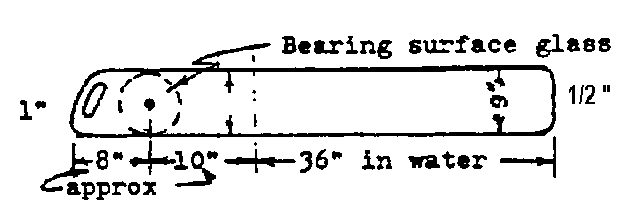
Any hull will do; the most common are lengths from 13 to 18 1/2 feet. Popular hulls are Grumman, Old Town, fiberglass and wood strippers. A rig consists of a leeboard, a leeboard thwart, sail, mast, mast thwart, mast step, boom, rudder-tiller (optional), a gaff for a lateen sail, hardware, and running rigging (rope i.e., line). Also required are a paddle, flotation and a bailer. This section will provide information for building a rig, which is non-invasive (to use the canoe without the sailing rig) as well as for converting your canoe to a sailing canoe.
You can also download the ACA Rig Plans - A (208K, in Adobe Acrobat format) to learn more.
THE LEEBOARD
Only one leeboard is needed to prevent the hull from slipping sideways, i.e., to provide lateral resistance. The leeboard and thwart should be strong and stiff since they will be under great pressure at times. Hardwood, such as oak or mahogany, for both lasts the longest. The leeboard can be one piece of hardwood or laminated pieces. An article on making a leeboard from laminated plywood by Dr. L. Haff is available from Marilyn Vogel.
Diagram A. - Leeboard longitudinal view
|
Diagram B. - Leeboard cross section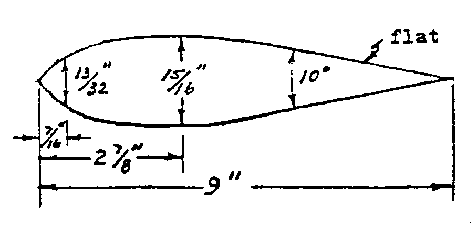
|
The widest point of the leeboard is 15/16 inch and 1/3 back from the leading edge. The bottom can be tapered and rounded.
The foil is a hydrodynamic shape to provide lift and lessen drag.
Diagram C. - Leeboard thwart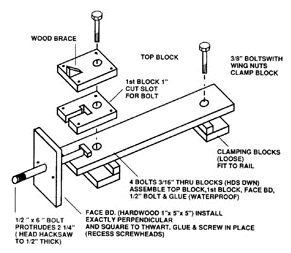
|
The length of the leeboard thwart should be based on moving the thwart from a wider part of the canoe to a less wide location.
An adequate width of the hardwood is four inches and thickness is one
inch. In the center you may want to place a bail with a block for the mainsheet.
Wood clamps on each end to hold the thwart onto the gunwale will allow you
to move the thwart later when you balance the rig. To fit the thwart onto the
gunwale use bolts that are 3/8 inch and wing nuts to clamp the loose blocks.
Diagram D. - Mounting the leeboard thwart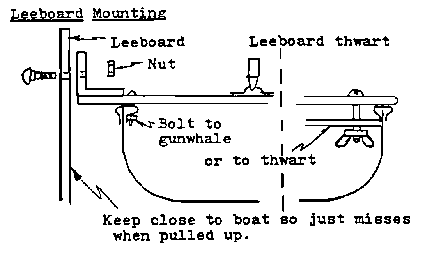
|
Mounting the leeboard to the thwart requires an L-shaped bracket, a 4X4 piece of hardwood or aluminum, from the thwart to the height of the leeboard. Make it exactly a right angle to the hull so the hull will steer strauight. You can fiberglass the wood on the thwart bracket next to the leeboard. You should be able to pivot the leeboard up and down.
Hardware: The leeboard is held to the bracket by a 1/2" or 3/8" thick carriage bolt. Use washers 1/8" thick and about 2" in diameter with a wing nut or a locknut. To ease moving the leeboard up and down use a thin plastic washer made from the lid of a can of coffee between the leeboard and bracket.
PHOTOS
Here are photos of three different leeboard mountings:
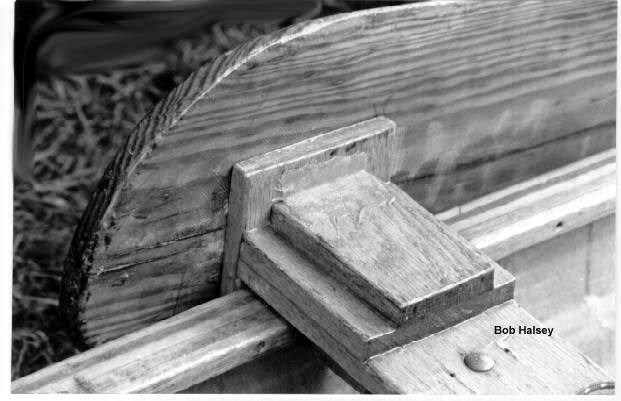 As shown in Diagram C, Bob Halsey uses an oak leeboard and a fiberglassed wood
bracket on the leeboard thwart. He has wood clamps to attach the leeboard thwart
to the gunwale.
As shown in Diagram C, Bob Halsey uses an oak leeboard and a fiberglassed wood
bracket on the leeboard thwart. He has wood clamps to attach the leeboard thwart
to the gunwale.
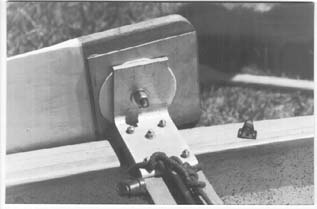 As shown in Diagram D, this aluminum angle bracket has a half inch carriage
bolt, a thin plastic washer, several additional washers and a lock nut. A smaller
bolt, about 3/8 inch, attaches the thwart to the gunwale.
As shown in Diagram D, this aluminum angle bracket has a half inch carriage
bolt, a thin plastic washer, several additional washers and a lock nut. A smaller
bolt, about 3/8 inch, attaches the thwart to the gunwale.
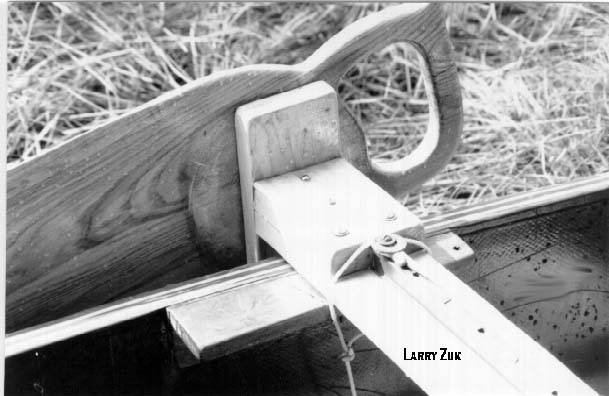 Larry Zuk uses a leeboard made of maple. He attaches the leeboard thwart to
a support piece next to the inwale. Two bolt holes indicate different locations
for the leeboard thwart because Larry uses two different sails.
Larry Zuk uses a leeboard made of maple. He attaches the leeboard thwart to
a support piece next to the inwale. Two bolt holes indicate different locations
for the leeboard thwart because Larry uses two different sails.
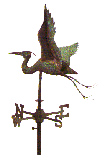 Main Page |